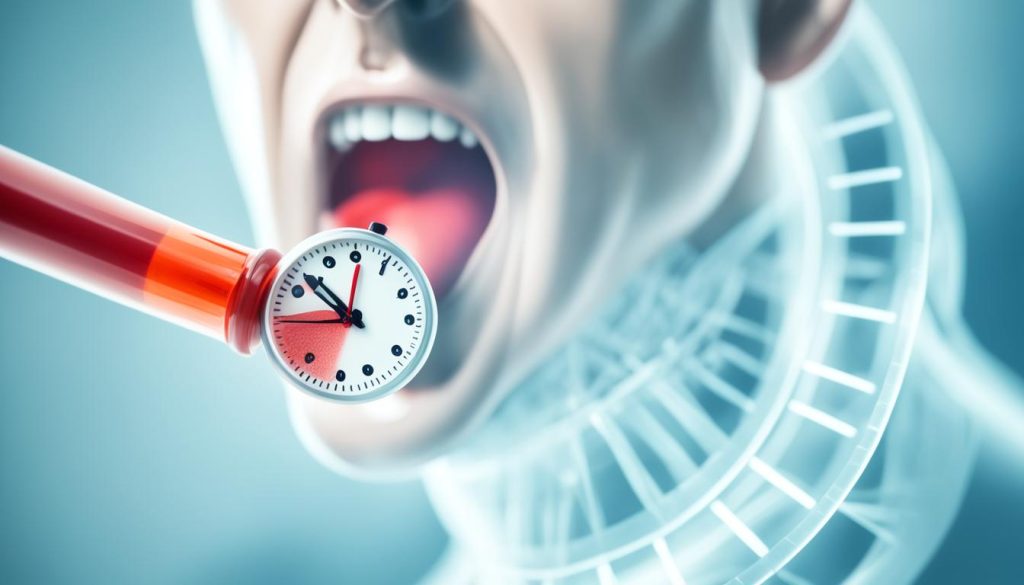If you’ve ever experienced strep throat, you know how uncomfortable and painful it can be. But how long does it take for strep throat to go away? Understanding the recovery time can help you better manage the symptoms and know when to expect relief.
Strep throat, caused by the bacteria Streptococcus pyogenes, is a common infection that leads to a sore throat. It is important to distinguish strep throat from a regular sore throat caused by a viral infection. Strep throat usually starts suddenly with symptoms such as a high fever, severe sore throat, redness in the throat, white patches on the tonsils, and swollen neck glands.
To confirm the diagnosis, a rapid antigen test can be done at the doctor’s office. It is important to treat strep throat with antibiotics to prevent potential complications such as rheumatic fever. With proper treatment, symptoms usually improve within a week, although it is important to complete the full course of antibiotics even if symptoms improve earlier.
In this article, we will explore the duration of strep throat, the symptoms to watch out for, how it is diagnosed, treatment options, potential complications, and self-care tips to manage the symptoms. By the end, you’ll have a better understanding of strep throat and how to effectively deal with it.
Understanding Strep Throat Symptoms
Strep throat is characterized by a range of symptoms that can vary from person to person. The most common symptom is a sore throat that worsens with swallowing. Other symptoms may include:
- Fever: Many individuals with strep throat experience a high fever.
- Chills: Some people may also experience chills, accompanied by shivering or shaking.
- Headache: A headache is a common symptom of strep throat, often accompanied by a feeling of overall body discomfort.
- Swollen neck glands: The lymph nodes in the neck may become swollen and tender to the touch.
In certain cases, a strep throat infection can also lead to the development of a rash known as scarlet fever. This rash is characterized by a red color and a rough texture, and it usually starts on the neck, chest, and underarms before spreading to other parts of the body.
These symptoms typically appear within 2 to 5 days after exposure to the strep bacteria. In most cases, the symptoms last for about a week.
Distinguishing Strep Throat from Viral Infections
It’s important to note that while strep throat can cause similar symptoms to other viral infections, most sore throats are caused by viral infections and do not require antibiotics. A healthcare provider can perform diagnostic tests, such as a rapid strep test, to accurately diagnose strep throat and determine the appropriate course of treatment.
Diagnosing Strep Throat
To accurately diagnose strep throat, a healthcare provider will conduct a thorough physical examination and may recommend further tests. The two primary diagnostic methods for strep throat are the rapid strep test and the throat culture.
The Rapid Strep Test
The rapid strep test is a quick and simple procedure that involves swabbing the back of the throat to collect a sample. This sample is then tested for the presence of the strep bacteria. The rapid strep test provides results within a matter of minutes, allowing for a timely diagnosis.
However, it’s important to note that the rapid strep test may sometimes produce false-negative results, especially if the infection is in its early stages. If the rapid strep test is negative, but the healthcare provider still suspects strep throat based on the symptoms and examination, a throat culture may be recommended for confirmation.
The Throat Culture
A throat culture involves collecting a sample of the bacteria from the back of the throat using a cotton swab. This sample is then transferred to a laboratory dish, where the bacteria can grow and multiply. The culture is observed for any signs of the strep bacteria, confirming the diagnosis.
The throat culture typically takes 1 to 2 days for the results to be available. While it may require more time than the rapid strep test, it is considered the gold standard for confirming a strep throat diagnosis.

During the diagnostic process, healthcare providers also consider other factors such as the patient’s medical history and the presence of symptoms like a high fever, severe sore throat, and swollen neck glands.
Once a strep throat diagnosis is confirmed, appropriate treatment, including the use of antibiotics, can be initiated to alleviate symptoms and prevent potential complications.
Treatment Options for Strep Throat
The primary treatment for strep throat is antibiotics. The most commonly prescribed antibiotics for strep throat are Penicillin or amoxicillin. The typical duration of the treatment course is 10 days. It is crucial to complete the full course of antibiotics, even if symptoms improve earlier. This ensures that the infection is completely eradicated and helps prevent the development of antibiotic-resistant bacteria.
Table: Antibiotics commonly prescribed for strep throat
| Antibiotics | Dosage | Treatment Duration |
|---|---|---|
| Penicillin | 500 mg – 1,000 mg | 10 days |
| Amoxicillin | 500 mg – 875 mg | 10 days |
In addition to antibiotics, there are several home remedies that can help alleviate the symptoms of strep throat. These remedies do not cure the infection but provide relief from the discomfort:
- Drinking warm liquids like tea with honey
- Gargling with salt water
- Staying hydrated
- Using over-the-counter pain relievers

Complications of Untreated Strep Throat
If left untreated, strep throat can lead to serious complications. Prompt treatment with antibiotics is essential to prevent these complications and ensure a speedy recovery.
One potential complication of untreated strep throat is the development of rheumatic fever. Rheumatic fever is a rare but serious condition that can affect the heart, joints, skin, and brain. It occurs as a result of an autoimmune response triggered by the strep bacteria.
Other potential complications include:
| Complication | Description |
|---|---|
| Kidney Disease | Strep throat can progress to a kidney infection known as post-streptococcal glomerulonephritis, which can cause inflammation and damage to the kidneys. |
| Scarlet Fever | Strep throat can also lead to scarlet fever, a bacterial infection characterized by a red rash that covers the body. It is accompanied by a high fever and a strawberry-like appearance of the tongue. |
| Abscess Formation | In some cases, untreated strep throat can lead to the formation of abscesses, which are pus-filled pockets that can develop in the throat or tonsils. |
Preventing Complications
To prevent these complications, it is important to seek medical attention and start antibiotic treatment as soon as possible. With proper treatment, strep throat symptoms typically improve within a week.

It is worth noting that strep throat is highly contagious, and proper hygiene practices such as frequent handwashing and avoiding close contact with infected individuals can help reduce the spread of the infection.
If you or someone you know is experiencing symptoms of strep throat, consult a healthcare provider for diagnosis and appropriate treatment. Treating strep throat promptly can help prevent complications and ensure a quick recovery.
Factors Affecting Strep Throat Risk and Transmission
Strep throat is a common bacterial infection that can affect individuals of all ages. However, it is more prevalent in children between the ages of 5 and 15. Close contact with someone who has strep throat, whether it’s a family member or a classmate, increases the risk of transmission. Additionally, crowded environments, such as daycare centers and schools, contribute to the spread of the infection.
Practicing good hygiene is crucial in reducing the risk of contracting or spreading strep throat. Regularly washing hands with soap and water is highly recommended. Covering the mouth and nose when coughing or sneezing, preferably with a tissue or the elbow, can also prevent the spread of infection.
Risk Factors for Strep Throat:
- Age: Children between the ages of 5 and 15
Ways of Transmission:
- Close contact with infected individuals
- Crowded environments, such as schools and daycare centers
By taking these simple precautions and promoting good hygiene practices, it is possible to reduce the risk of strep throat and prevent its transmission.
Self-Care Tips for Managing Strep Throat Symptoms
Along with antibiotic treatment, there are self-care measures that can help manage the symptoms of strep throat. These include:
- Drinking warm liquids, such as tea with honey
- Gargling with salt water
- Sucking on throat lozenges or popsicles
- Using a humidifier to alleviate throat dryness
- Taking over-the-counter pain relievers
It is important to rest, stay hydrated, and avoid irritants such as smoking or exposure to secondhand smoke. These self-care measures can help alleviate symptoms and promote faster recovery.
| Tips for Managing Strep Throat Symptoms |
|---|
| Drinking warm liquids, such as tea with honey |
| Gargling with salt water |
| Sucking on throat lozenges or popsicles |
| Using a humidifier to alleviate throat dryness |
| Taking over-the-counter pain relievers |
Conclusion
Strep throat, a common bacterial infection that leads to a sore throat, requires prompt treatment with antibiotics to prevent complications. It is important to distinguish strep throat from a regular sore throat caused by a viral infection. Symptoms of strep throat usually improve within a week of starting antibiotics, although it is crucial to complete the full course of medication as prescribed. Along with antibiotic treatment, self-care measures such as hydrating, resting, and using throat remedies can help alleviate symptoms and promote faster recovery. If you suspect you or your child may have strep throat, it is essential to consult a healthcare provider for proper diagnosis and treatment.




